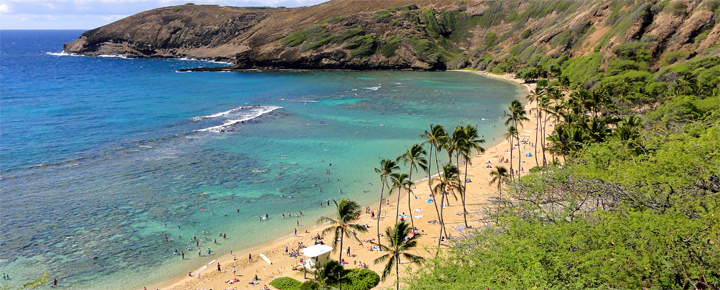University of Hawaii reported recently that the future of the beach at Hanauma Bay looks very troubling. It’s a reminder that over the past century, the islands of Oahu, Maui, and Kauai have seen a quarter of their beaches disappear. Hanauma Bay is a Nature Preserve dedicated to safeguarding fragile marine life. It’s one of the most popular attractions on Oahu and a premier spot for snorkeling.
Following five years of groundbreaking research into the impact of rising sea levels on the renowned Hanauma Bay Nature Preserve, researchers from UH Manoa Institute of Marine Biology uncovered very alarming predictions. The most unsettling news is that an astonishing 88% of the nature preserve’s pristine beach will likely be underwater by 2030.
The study looked not only at the impacts of the rising sea level but also at other factors that would help facilitate sustainable tourism planning, including assessing the impact of visitors.
Hanauma Bay is closed on Mondays and Tuesdays, but when they are open they see an average of more than 1,400 people a day. About 85% of these people are out-of-state visitors who engage in “ocean recreation activities.” Good visibility to see fish underwater and the warm temperatures of Hawaii waters are a big draw for them and locals.

Leading edge research paints grim future for Hanauma Bay.
The study used sea-level rise models that were developed by the School of Ocean and Earth Science and Technology’s Sea Level Rise Laboratory and Pacific Islands Ocean Observing System. They reported that the lowest predicted sea-level rise (1/2 foot), combined with the highest tide, will result in 88% of the preserve’s usable beach being lost to the ocean in the next 7 years.
Even researchers were astonished by their findings about Hanauma Bay.
They said that they hope their findings about the expected impact will “assist management in preparation and to develop recommendations, other alternatives, and solutions.”
The research group also uncovered a myriad of other findings during the course of their study. They monitored fish populations using non-invasive stereo video techniques, which revealed previously unknown insights into fish behavior and fish interactions with humans at the bay.
While Hanauma Bay was closed during Covid, many of the fish species found there became more approachable, seemingly undeterred by the presence of humans. Once Hanauma Bay reopened, however, they reported certain species, including wrasses and butterflyfish, became less receptive to close human encounters.
The pandemic-related closure of Hanauma Bay had other positive impacts on the wildlife present. One location popular for snorkeling, the keyhole, saw a remarkable increase in its fish communities during the duration of the closure.
In addition, the survey addressed the shift in visitor demographics, wherein Japanese visitors dropped precipitously to under 1% of all 2022 visitors; in previous assessments, this share had been as much as 25%. At the same time, the percentage of Hawaii residents coming to the preserve went up, from 3% to 13%. That shift is at least in part related to the fact that while visitors pay $25 for entry, Hawaii residents may enter free of charge.
Hanauma Bay’s preservation is of great importance.
That is true for the Hawaii tourism industry as well as for every other reason. At one time, there were up to 4.5 million visitors arriving annually at the preserve. Now, however, Hanauma Bay is only expecting to entertain about half a million in all of 2023.
Preserving Hanauma Bay also requires maintaining lower visitor levels. That number is currently 1,400 people per day. One of the study’s findings was that during the Covid closure, water clarity increased by 56%. Since it has reopened, however, water clarity has decreased.
What rising sea water levels mean for Hawaii.
The state reports that the sea level at Hilo Bay has risen by 10 inches since 1950. It’s now rising faster, at a rate of 1 inch every 4 years. This will lead to increased frequency and reach of coastal flooding. Hawaii also reports that 13 miles of Hawaii beaches are already gone due to coastal erosion, including 10% of Oahu beaches. The state says that 70% of beaches throughout Hawaii are currently threatened by rising sea levels.
The rising sea levels also impact traditional practices including fishpond maintenance, the cultivation of Hawaiian sea salt, and gathering from nearshore fisheries.
On Maui, Kaanapali Beach is fast-disappearing, while Waikiki beaches and the popular Lanikai Beach in Kailua are also particularly vulnerable.
How and When to Visit Hanuama Bay on Oahu.
Make your reservations online two days before your visit; reservations are for specific time slots, starting at 7 am. There is a $25 entry fee for visitors 13 and older; entry for Hawaii residents is free. Parking is $3.00 for visitors and $1.00 for residents, payable on-site.
Wednesday through Sunday you can enter from 6:45 am to 1:30 pm. All visitors must leave by 4:00 pm. Hanauma Bay is closed on Monday and Tuesday.
TheBus no longer drops passengers at Hanauma Bay.
Guest services include a food and snorkel concession, a gift shop, restrooms, and showers.
For more information, call 808-768-6861.
Source : BeatOfHawaii











